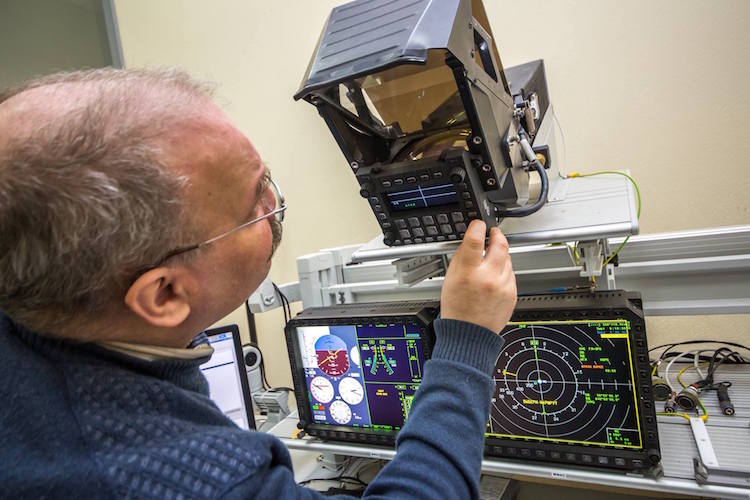
Cockpit display systems for the Su-57 being tested by a Sukhoi Design Bureau engineer. Photo, courtesy of Sukhoi Design Bureau.
The communications, navigation and surveillance systems featured on the Su-57 are described by its developers as an integrated avionics “complex” featuring a network centric architecture with a unique approach to embedded computer processing and data transmission. Engineers from the Sukhoi Design Bureau, a design arm of the Russian Sukhoi Corporation in cooperation with Radioelectronic Technologies Concern (KRET), provided an overview of how the systems work recently through an emailed interview with Avionics International.
The Su-57 will eventually replace Russia’s multi-purpose all-weather fourth generation Su-27 fighter jet fleet. It is positioned as the world’s main competitor to the F-35.
“From the perspective of electronics engineers, modern fighters have already reached a level where a sharp growth of their capabilities is no longer possible. However, we know that modernization of their frames and engines could lead to a 20–30 percent advantage in superiority over their predecessors. At the same time, the design of new ‘brains’ or avionics – could result in an increase of their efficiency and combat capabilities by several times,” said Givi Janjgava, deputy director general for research and development of on-board equipment of the Radioelectronic Technologies Concern

An Su-57 undergoes ground testing. Photo, courtesy of Sukhoi Design Bureau.
The new complex is based on Russian multi-core chips and an operating system, which works within a “real-time” mode in close communications with other fighter jets, military transport aircraft and ground forces. This provides an opportunity to not only to exchange information with other fighters, but also to perform a lead role, giving orders and setting priorities during the attack.
According to Dmitry Gribov, a chief designer of the new complex, it will replace the fourth generation avionics designed in 2004 that operated on the basis of the Russian Baguet on-board computer system.
Prior to each Su-57 flight, a special flight program is prepared and loaded into the flight management computer. The program comprises intelligence data, information about weapon systems of the target, its coordinates and other relevant data. This program can also be adjusted during the execution of a combat mission at any time .
Gribov said the new system took four years to develop.
“The avionics on the Su-57 fighter is based on the entirely new architecture, which, to date, has never been used in Russian military aviation. It is operated on the concept of network-centricity, which involves a consistent upgrading of onboard systems and operating complexes of the aircraft. The multi-core base of the complex provides almost unlimited possibilities,” said Gribov.
Sukhoi Design Bureau engineers describe the Su-57 avionics as featuring a central computer which controls all of the aircraft systems, including weapons and intellectual support of the pilot. The computer simultaneously performs the role of an electronic pilot, an electronic navigator and an electronic flight engineer capable of automatically recognizing and determining adversaries and targets. In addition, it is capable of planning the most optimal route to an objective.
There is also a control system featured within the avionics which controls almost all of the key systems of the aircraft, including its location, navigation and communication.
“If in the past, in order to calculate the functions of each unit we had to use separate systems, the use of the new avionics helps to to implement control for all systems of the aircraft simultaneously,” said Gribov.
In totality, Su-57’s onboard software already exceeds 4 million lines of code and will be further expanded through the introduction of a number of complex functional modes for processing complex information.
(On November 19th, 2018, The Moscow Times published video of the Su-57 doing combat flight testing in Syria, shown above.)
According to the designers, they use another approach for the design of the avionics for the Su-57 that is unique from the approach used by their U.S. colleagues during the design of the F-22 and F-35 fighter jet systems.
“We worked in similar directions with the US designers at the initial stage. However, in contrast to them, we decided not to load the main onboard computer of Su-57 with processing the entire volume of primary data. Currently Su-57’s avionics complex is designed to process just the ‘upper part’ of data package. This allows it to work faster, more reliably and efficiently,” said Gribov.
Data exchange for Su-57 onboard systems are conducted via fiber-optic channels. The fourth-to-fifth generation transition from copper to optical fiber allowed the designers to significantly increase the speed and volume of data transmission, while reducing the weight of the cable network and improving its noise immunity. Whereas data transmission over a traditional copper cable produces a speed on the order of 10-100 Mbit/s, fiber optics is almost 8 Gbit/s.
Designers also say the network structure of Su-57’s avionics complex increases reliability of all of its units, which means if one of the computers fails, the systems automatically switch to another unit. Additionally, the use of a centralized processor reduces the weight of the entire complex by almost two times, compared to its previous analogue-centered Russian fighter jet avionics.
Gribov and the engineering team also describe the new avionics as enabling the Su-57 to be impenetrable by enemy electronic countermeasures. This will provide it with additional time during the detection of targets and directing missiles with precision-guided bombs.